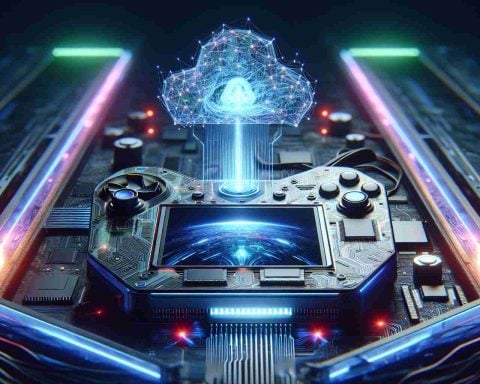- The robotics competition between China and the U.S. is intensifying, with significant developments showcased at CES.
- Nvidia’s CEO highlighted the imminent revolution in robotics, indicating a transformative future ahead.
- China demonstrated its capabilities at the Spring Festival Gala, featuring Unitree’s H1 robots performing a folk dance.
- As of 2025, both nations are investing heavily in humanoid robotics, with a notable representation from both sides at major events.
- The race for robotic supremacy promises to evolve human-machine interactions dramatically in the near future.
In an electrifying showdown of innovation, the battle for robotic dominance between China and the United States has reached fever pitch! At the glimmering halls of the Consumer Electronics Show (CES) in Las Vegas, Nvidia’s CEO, Jensen Huang, captivated audiences with a bold declaration—robotics are on the brink of a revolution. With 14 stunningly crafted humanoid robots striking poses beside him, the future of technology seemed alive and ready to take its first steps.
But China is not backing down! Just weeks later, during the mesmerizing Spring Festival Gala, the world marveled as Unitree’s H1 humanoid robots twirled in a flawless folk dance, showcasing cutting-edge AI and cloud technology to over a billion viewers. This dazzling performance exemplified China’s relentless push towards becoming a leader in robotics.
As we step into 2025, the atmosphere is charged with anticipation. With an array of companies vying for their piece of this high-stakes market, the landscape of humanoid robotics is shifting. Six of the remarkable robots highlighted at CES hailed from Chinese firms, while four represented American ingenuity, illustrating that both nations are striving for industry supremacy.
The takeaway? The robotics race is heating up, with spectacular displays and innovations promising a future that may redefine human and machine interactions. Prepare for an exhilarating journey as these two powerhouses propel us into a new era of technology!
Robotics Revolution: Who Will Emerge Victorious in the Clash of Titans?
## The Race for Robotic Supremacy
In the rapidly evolving world of robotics, the competition between China and the United States intensifies, with both nations unveiling groundbreaking innovations that promise to reshape the industry. As we survey the landscape in 2025, several new trends and insights emerge, providing a deeper understanding of the factors impacting the future of humanoid robotics.
Innovations in Robotics
– AI and Machine Learning Integration: Recent advancements in AI and machine learning are enabling robots to perform complex tasks with increasing autonomy. For instance, the implementation of deep learning algorithms facilitates more sophisticated decision-making processes in humanoid robots.
– Enhanced Mobility and Dexterity: The latest models from companies like Boston Dynamics and Unitree are equipped with advanced sensory systems that allow for improved mobility and the ability to handle objects delicately, setting new standards for physical interaction.
– Collaborative Robots (Cobots): There is a noticeable trend towards developing robots that work alongside humans in industrial settings. These cobots are designed to enhance efficiency while ensuring safety in mixed-human-environment operations.
Pros and Cons of Humanoid Robotics
– Pros:
– Increased Efficiency: Robots can perform repetitive tasks faster and more accurately than humans, increasing production rates.
– Automation of Dangerous Jobs: Robots can take over hazardous tasks, reducing workplace injuries and fatalities.
– 24/7 Availability: Unlike human workers, robots do not require breaks and can work continuously, improving overall productivity.
– Cons:
– Job Displacement: The rise of robotics may lead to unemployment in sectors where robots can perform tasks more efficiently than humans.
– High Initial Costs: The development and deployment of advanced robotics technology can be capital-intensive, posing a barrier to entry for smaller companies.
– Ethical Concerns: The use of humanoid robots raises ethical questions regarding autonomy, privacy, and the nature of human-robot relationships.
Market Forecasts and Insights
The humanoid robotics industry is projected to experience significant growth over the next decade. According to market analysis, the global humanoid robotics market is expected to reach USD 11 billion by 2027, driven by increasing demand in sectors such as healthcare, manufacturing, and entertainment.
3 Key Questions and Answers
1. What are the leading technologies driving the evolution of humanoid robots?
The integration of artificial intelligence, machine learning, and advanced materials is at the forefront of robotic development. These technologies enhance the robots’ capabilities in perception, mobility, and interaction.
2. How do the US and China approach robotics differently?
While both countries are heavily investing in robotic research, the US tends to focus on innovation driven by private companies and venture capital. In contrast, China’s strategy involves state-funded initiatives and partnerships between government and industry, leading to rapid advancements and scale.
3. What ethical considerations surround the implementation of humanoid robots?
The deployment of humanoid robots raises ethical concerns regarding job displacement, privacy, and the humanization of machines. It prompts societal debates on the balance between technological advancement and potential disruption of social norms.
Suggested Related Links
– TechCrunch
– Forbes
– Wired
As the battle for robotics supremacy continues, the innovations and challenges of humanoid robots will undoubtedly shape the future of industries globally, prompting us to rethink our relationship with technology. Stay tuned for further developments in this gripping technological rivalry!




















